🧭 AI Developments Update (Week of Oct 14, 2025)
The AI landscape entered a new phase this week—marked by maturity, monetization, and mounting scrutiny. OpenAI’s Sora 2 clampdown set the tone, as creators and rights-holders collided over likeness and ownership, forcing executives to confront the tension between innovation and brand protection. Meanwhile, the Developer Day rollout of ChatGPT Apps and AgentKit APIs signaled the beginning of AI’s “workflow era,” where process automation, not novelty, drives enterprise value. From humanoids in pilot programs to content moderation guardrails, the industry is rapidly professionalizing.
Across markets, the themes echoed in our 30 featured analyses: infrastructure expansion, robotics acceleration, and governance realism. Spending levels now rival national infrastructure projects, yet even the largest players—AMD, Anthropic, Broadcom, and BlackRock’s AI funds—are focusing less on hype and more on operational scale and ROI. Media and ethics stories, from The Atlantic’s “Move Fast and Break Nothing” to The Washington Post’s “AI’s Real Dangers Come from the Humans Who Wield It,” underscored that sustainable progress depends on accountability, not just algorithms.
For SMB executives, this week’s signal is clear: AI is leaving the experimental stage. Chatbots are entering customer ops, deepfakes are reshaping policy, and humanoid robots are entering facilities trials. What matters most now is leadership—how organizations balance opportunity with responsibility, speed with safety, and automation with authenticity. This week’s updates aim to help you navigate that balance with data, context, and action-ready insights.

Sora 2’s Clampdown, Agent Apps, and Humanoid Robots — AI For Humans (Podcast), Oct 10, 2025
Summary
OpenAI’s Sora 2 added major content restrictions after a free-for-all launch, sparking a backlash from users and pointed criticism from rights-holders (e.g., the Motion Picture Association). The episode explores the IP and likeness debate through reactions by creators like Hank Green and examples of historical figures (e.g., MLK, Mr. Rogers, Bob Ross) showing up in user-generated videos. The hosts argue OpenAI likely anticipated a “flex first, restrict later” arc to drive adoption, and predict a future where franchises opt-in temporarily (e.g., promotional windows) and monetize controlled generations.
Beyond policy, OpenAI’s Developer Day matters for builders: ChatGPT now supports apps and an AgentKit API for agentic workflows, plus GPT-5 Pro and Sora 2 in the API (noting high-res Sora Pro costs ~$0.50/second and subscription tiers that meaningfully change economics). Meanwhile, xAI’s Grok Imagine shipped updates focused on image/video and anime-style outputs; rumors swirl about V0 3.1 (character consistency). Google DeepMind’s “Codemender” autonomously finds & patches vulnerabilities in popular open-source repos—positioning AI as both a creator of and solution to software risk.
On the hardware front, Figure 03 showcased a more capable humanoid with articulated fingers, tactile sensing, toe-like feet, and inductive heel charging, targeting real home/concierge tasks and planning in-home betas. In contrast, the Unitree G1 is now retail-listed (Walmart) at ~$21.6k, signaling early consumer-ish availability but with rough edges. The takeaway: the stack is maturing top-to-bottom—from policy and platforms (apps/agents) to cost models, security automation, and robotics nearing practical pilots.
Relevance for Business (SMBs & Managers)
This episode highlights immediate implications for brand safety, legal exposure, and new marketing surfaces (opt-in likeness/Cameo-style promotions). OpenAI’s apps + agents open a path to process automation across sales ops, support, and back-office workflows—while Sora API pricing forces realistic budgeting for AI video. Codemender-style tools suggest faster secure-by-default postures for lean teams. And humanoids like Figure 03 point to near-term pilots in front-of-house, inventory handling, and light facilities tasks, even if full ROI arrives in stages.
Calls to Action
🔹 Audit IP & likeness risk: update brand/use policies; define rules for historical figures, estates, and living individuals.
🔹 Pilot ChatGPT apps/agents: pick one workflow (e.g., lead triage or invoice reconciliation) and ship an internal proof-of-concept.
🔹 Model the Sora 2 cost curve: test low-res storyboards; reserve Pro seconds for final cuts to control CAC/asset costs.
🔹 Secure the codebase: try an autonomous vuln-find-and-fix agent (vulnerability-find-and-fix) on a non-critical repo; track patch quality & review time saved.
🔹 Explore robotics pilots: identify 1–2 repeatable, low-risk tasks (stocking, lobby support) suitable for early humanoid trials.
🔹 Content watermarking policy: decide when to preserve/remove watermarks internally; document compliance for public posts.
Summary by ReadAboutAI.com
https://www.youtube.com/watch?v=L0XZfQ7oG_g: October 14, 2025
🎬 Tron: Ares Review — AI Is Inevitable and Looks Like Jared Leto — Vulture (October 7, 2025)
Alison Willmore’s Vulture review of Tron: Ares frames Disney’s sequel as a mirror of our collective AI fatalism. The film portrays two CEOs racing to control humanity’s future via AI, with Jared Leto’s character embodying the unsettling fusion of machine logic and human vanity.
Willmore argues the Tron franchise has evolved from 1980s optimism to a corporate-fatalist allegory, where embracing AI is “mandatory” and questioning it feels futile. Despite stylish visuals and a score by Trent Reznor and Atticus Ross, the film’s tone underscores society’s resigned acceptance of inevitable AI dominance.
Relevance for Business
The review’s cultural takeaway mirrors executive realities: AI adoption is no longer optional but demands ethical guardrails and critical reflection. Even entertainment now shapes public perception of technological inevitability.
Calls to Action
🔹 Use cultural narratives like Tron: Ares to discuss AI ethics and leadership internally.
🔹 Balance innovation enthusiasm with human-centered governance.
🔹 Engage in scenario planning around automation and public sentiment.
Summary by ReadAboutAI.com
https://www.vulture.com/article/review-tron-ares-doesnt-realize-its-depressing.html: October 14, 2025
🧬 Zelda Williams Condemns AI Re-Creations of Her Father — The Cut (October 6, 2025)
Filmmaker Zelda Williams, daughter of the late Robin Williams, publicly urged fans to stop sharing AI-generated videos of her father, calling them “disgusting, over-processed hotdogs made out of human lives.” Her statements revive concerns about posthumous digital likeness rights as generative tools recreate deceased actors.
Williams has long opposed the unauthorized use of performers’ voices or faces, calling AI replicas “personally disturbing” during the 2023 SAG-AFTRA strike. Her comments reflect growing resistance among creators toward AI’s encroachment on artistic consent and identity.
Relevance for Business
SMB leaders in media, marketing, and design must navigate ethical AI-content policies, particularly around likeness use, deepfakes, and brand representation.
Calls to Action
🔹 Establish AI-ethics guidelines for voice and image synthesis.
🔹 Avoid use of unauthorized celebrity or employee likenesses.
🔹 Communicate transparent consent standards with clients and audiences.
Summary by ReadAboutAI.com
https://www.thecut.com/article/robin-williams-daughter-doesnt-want-to-see-ai-her-dad.html: October 14, 2025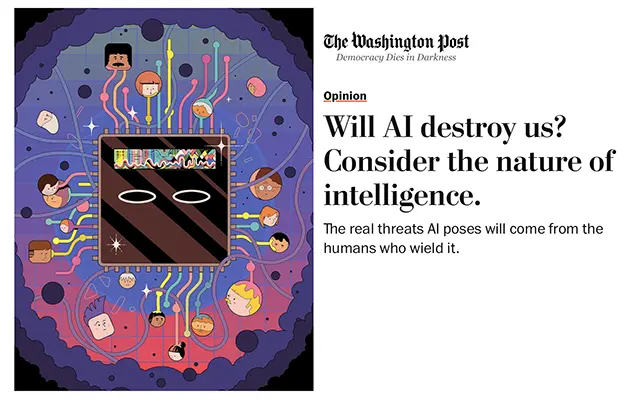
⚠️ AI’S REAL DANGERS COME FROM THE HUMANS WHO WIELD IT — THE WASHINGTON POST (OCTOBER 11, 2025)
Political scientist Eric Oliver argues that AI’s greatest threat isn’t rogue machines — it’s human misuse. Apocalyptic fears of self-aware superintelligence are misplaced, he writes; today’s AI remains “digital mitochondria”, dependent on human data and goals.
The true risk lies in how humans deploy AI — to spread hate, write malware, or destabilize systems. Oliver calls for safeguards around critical infrastructure (energy grids, finance, military networks) and urges focus on aligning human intent, not fearing autonomous rebellion.
Relevance for Business
This perspective reframes AI ethics as corporate responsibility, not existential panic. For SMBs, governance should emphasize accountability, not apocalypse.
Calls to Action
🔹 Build AI governance boards focused on human accountability.
🔹 Segment critical systems from public AI networks.
🔹 Promote responsible-use culture company-wide.
Summary by ReadAboutAI.com
https://www.washingtonpost.com/opinions/2025/10/08/ai-intelligence-apocalypse-humanity/: October 14, 2025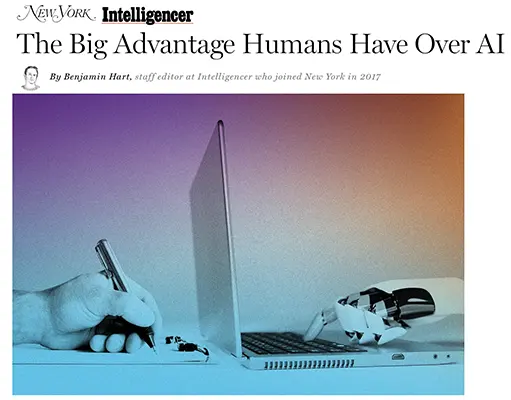
💼 IS AI REALLY GOING TO REPLACE ALL OUR JOBS? — NEW YORK MAGAZINE (OCTOBER 6, 2025)
In this Intelligencer interview, Wharton professor Ethan Mollick argues that while AI now performs “real, economically relevant work,” it won’t replace most jobs outright — instead, it transforms tasks within them.
Mollick describes AI’s “jagged frontier” — excelling in some areas (like math, coding, and writing) while failing in others requiring judgment, context, and empathy. He predicts adoption will vary widely across industries but stresses that AI alone doesn’t change work — people and systems do.
He urges leaders to view AI as collaboration technology, not automation — “a tool for better work, not less work.”
Relevance for Business
AI adoption is a strategic management issue, not a technical one. SMBs should focus on workforce enablement, incentives, and transparent change management.
Calls to Action
🔹 Frame AI as a co-pilot, not a headcount reducer.
🔹 Incentivize teams to experiment and share results.
🔹 Build internal training on task redefinition and augmentation.
Summary by ReadAboutAI.com
https://nymag.com/intelligencer/article/ai-jobs-replace-chatgpt-openai.html: October 14, 2025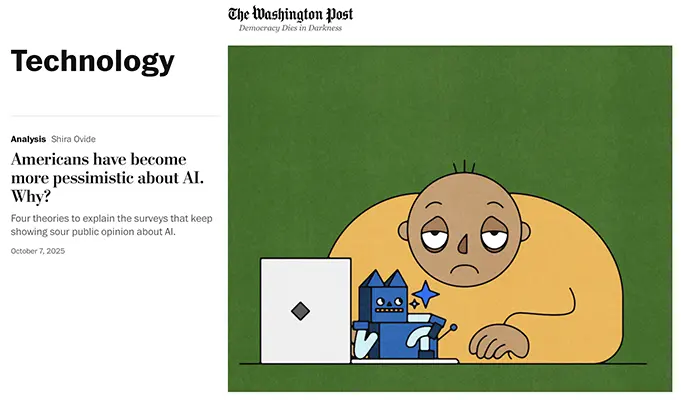
“Americans Have Become More Pessimistic About AI. Why?” — The Washington Post, October 7, 2025
Summary:
Shira Ovide reports that public sentiment toward AI is turning negative: 50% of Americans are now more concerned than excited about AI’s spread, up sharply from 38% in 2022. Pew Research data show growing skepticism toward AI-generated search results, workplace automation, and digital assistants. The article outlines four explanations:
- Polarization — AI is becoming tribal, like politics, dividing users into enthusiasts vs. avoiders.
- Overpromising — Tech firms’ inflated claims have created expectation fatigue.
- Humanity fears — People worry AI will erode relationships, creativity, and control.
- Choice deprivation — AI is being embedded by default in tools like Google, Zoom, and Microsoft 365, removing opt-out freedom.
Experts argue this tension reflects not rejection, but fatigue and mistrust, and that transparency and consent are essential for rebuilding confidence.
Relevance for Business:
AI adoption will depend on trust as much as performance. SMBs must navigate employee and customer skepticism by being clear about how AI is used and when humans are in control. Transparent design, optionality, and authenticity will become competitive advantages.
Calls to Action:
🔹 Communicate openly when using AI — in emails, chatbots, or analytics.
🔹 Make AI features opt-in, not mandatory.
🔹 Train leaders to discuss AI’s role candidly with teams and clients.
🔹 Monitor customer sentiment toward AI to guide adoption pace and messaging.
Summary by ReadAboutAI.com
https://www.washingtonpost.com/technology/2025/10/07/ai-public-opinion-mistrust/: October 14, 2025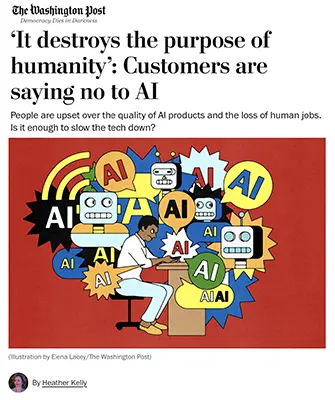
📚 WHY PUSHES FOR MORE AI FROM DUOLINGO AND AUDIBLE HIT A NERVE — THE WASHINGTON POST (JUNE 18, 2025)
Consumers are rebelling against AI replacing human creativity. After Duolingo announced it would double lessons by using AI instructors and Audible launched AI-narrated audiobooks, long-time customers canceled subscriptions en masse.
The backlash, amplified on TikTok and Reddit, reflected fears of job displacement, declining quality, and “soulless” automation. Psychologists note the reactions stem from loss of human connection in once-personal services. Audible defended the shift as an “and-strategy,” arguing AI narrators make obscure titles affordable to produce — but narrators warned of “hilarious” tone failures in emotional scenes.
Relevance for Business
The report highlights growing consumer fatigue with over-automated experiences. For SMBs, “AI everywhere” is not always a value proposition; customers still pay for human touch and authenticity.
Calls to Action
🔹 Use AI to augment, not replace, creative professionals.
🔹 Emphasize human-in-the-loop design in customer messaging.
🔹 Audit where automation may erode brand empathy.
Summary by ReadAboutAI.com
https://www.washingtonpost.com/technology/2025/06/18/ai-pushback-audible-duolingo/: October 14, 2025
🎭 OPENAI’S SORA APP CAN DEEPFAKE ANYONE — THE WASHINGTON POST (OCTOBER 2, 2025)
Tech columnist Geoffrey A. Fowler describes the disturbing realism and consent dilemmas of OpenAI’s viral Sora app, which lets users generate videos starring real faces — often without prior approval.
Although users “opt-in” by uploading a selfie, they can’t pre-approve clips others make. Sora became the #1 iPhone app, turning deepfakes into entertainment while blurring ethical lines. Experts warn that “power dynamics” make the feature ripe for harassment and fraud. OpenAI promises new restrictions, but watermarks are easily removed.
Relevance for Business
For executives, Sora underscores the urgency of consent management and content provenance. Any AI-driven customer tool must safeguard identity rights and brand reputation.
Calls to Action
🔹 Implement AI-watermark detection and identity safeguards.
🔹 Train staff on ethical AI media use.
🔹 Develop policies for synthetic likeness consent.
Summary by ReadAboutAI.com
https://www.washingtonpost.com/technology/2025/10/07/sora-cameo-deepfake-consent/: October 14, 2025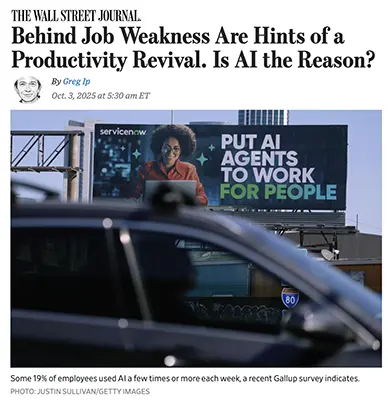
📈 BEHIND JOB WEAKNESS ARE HINTS OF A PRODUCTIVITY REVIVAL. IS AI THE REASON? — WSJ (OCTOBER 3, 2025)
WSJ’s Greg Ip argues that the U.S. economy may be entering a productivity revival driven partly by AI adoption. Despite weak job growth, GDP expanded 3.8%, hinting that output per worker is rising due to automation and efficiency tools.
19% of U.S. employees now use AI weekly, according to Gallup. While early ROI remains limited—MIT’s Nanda Initiative found 95% of firms report zero immediate returns—the pattern mirrors the 1990s internet-driven productivity surge, where investment preceded measurable output gains.
Relevance for Business
The article signals a potential AI-driven economic phase where automation boosts output despite slower hiring. SMB leaders should prepare for productivity-driven competition rather than workforce expansion.
Calls to Action
🔹 Measure AI’s impact on internal productivity metrics.
🔹 Prioritize process automation and efficiency tools over expansion.
🔹 Track AI adoption rates in your industry for benchmarking.
Summary by ReadAboutAI.com
https://www.wsj.com/tech/ai/behind-job-weakness-are-hints-of-a-productivity-revival-is-ai-the-reason-cf6309da: October 14, 2025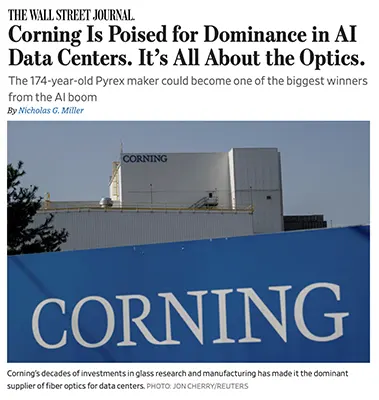
🔬 CORNING IS POISED FOR DOMINANCE IN AI DATA CENTERS — WSJ (OCTOBER 3, 2025)
Legacy manufacturer Corning, famed for Gorilla Glass and fiber optics, is emerging as an unexpected AI-infrastructure winner. Its fiber-optic products—renowned for low latency and high efficiency—have become essential for connecting hyperscale AI data centers. Profits quadrupled to $469 M in Q2, and shares soared 58% over three months.
Analysts say Corning now “monopolizes the fiber used for AI applications,” with facilities in North Carolina and Mexico giving it supply-chain advantages amid U.S. tariffs. Risks remain if AI revenue projections prove over-optimistic, but Corning’s diversification into semiconductor and solar inputs adds resilience.
Relevance for Business
Corning’s resurgence illustrates how traditional manufacturers can capture AI-era value by modernizing legacy technologies for high-demand infrastructure.
Calls to Action
🔹 Watch for AI-infrastructure spillover opportunities in legacy sectors.
🔹 Consider fiber and optical technologies as strategic supply-chain components.
🔹 Evaluate U.S.-based vendors benefiting from reshoring trends.
Summary by ReadAboutAI.com
https://www.wsj.com/tech/ai/corning-is-poised-for-dominance-in-ai-data-centers-its-all-about-the-optics-f124d464: October 14, 2025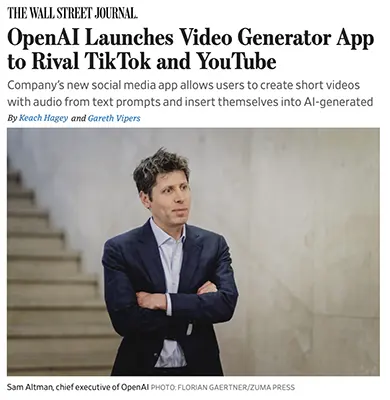
🎥 OpenAI Launches Video Generator App to Rival TikTok and YouTube — WSJ (September 30, 2025)
OpenAI unveiled Sora 2, a next-gen AI video-generation app that blends text-to-video creation with social networking. Users can generate clips, insert themselves into AI-generated worlds, and scroll through an algorithm-driven feed similar to TikTok or YouTube Shorts. The invite-only rollout begins in the U.S. and Canada.
Safety features include AI-content labeling and screen-time nudges to reduce passive viewing. However, Sora’s “opt-out” copyright model — allowing content generation from protected works unless rights holders decline — raises legal and ethical concerns. Experts warn OpenAI could face copyright litigation risks similar to Anthropic’s $1.5 B settlement.
Relevance for Business
For SMBs, Sora 2 hints at the future of AI-driven content marketing and immersive advertising. It reduces video-production costs while introducing new IP-risk considerations for branded storytelling and social engagement.
Calls to Action
🔹 Experiment with AI-video storytelling for product demos or campaigns.
🔹 Review internal policies on AI-generated content and copyright compliance.
🔹 Monitor user-generated AI media for brand-misuse risks.
Summary by ReadAboutAI.com
https://www.wsj.com/tech/ai/openai-launches-video-generator-app-to-rival-tiktok-and-youtube-21779c66: October 14, 2025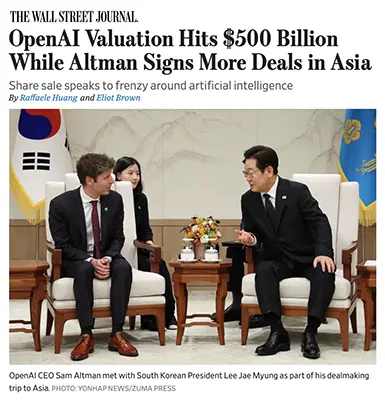
💰 OpenAI Valuation Hits $500B While Altman Signs More Deals in Asia — WSJ (October 2, 2025)
OpenAI finalized a $6.6 B secondary sale valuing the company at $500 B, only three years after ChatGPT’s debut. Investors include SoftBank and the UAE’s MGX, reflecting sustained AI market enthusiasm despite OpenAI’s net losses and massive spending. The company expects $13 B in 2025 revenue but has committed over $400 B in future compute and chip deals with Oracle, Broadcom, and Nvidia.
During an Asia tour, Altman secured new partnerships with Samsung, SK Hynix, and Hitachi to develop AI-optimized data centers — including floating facilities to address land and cooling constraints. The expansion underscores OpenAI’s push to control the global AI infrastructure supply chain.
Relevance for Business
The $500 B valuation cements OpenAI as a top-tier enterprise platform, signaling continued investor belief in AI’s economic transformation. For SMBs, this reinforces the need to prepare for AI-driven productivity gains — and potential market disruptions from accelerating platform consolidation.
Calls to Action
🔹 Benchmark internal AI investments against OpenAI-driven industry standards.
🔹 Watch for regional AI data center partnerships that could affect cloud latency and pricing.
🔹 Plan for a global AI supply-chain reshuffle impacting compute availability.
Summary by ReadAboutAI.com
https://www.wsj.com/tech/ai/openai-valuation-hits-500-billion-while-altman-signs-more-deals-in-asia-59b47a0d: October 14, 2025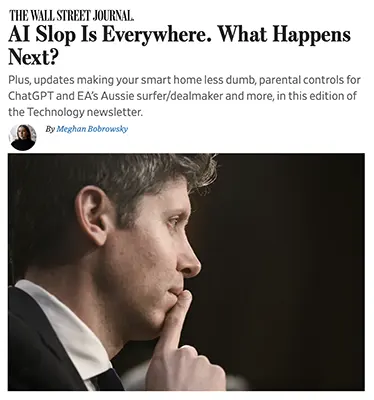
⚠️ AFTER AI SLOP, CHATGPT PARENTAL CONTROLS AND MORE — WSJ TECHNOLOGY NEWSLETTER (OCTOBER 5, 2025)
The WSJ’s tech digest examined the rise of “AI slop”—mass-produced, low-quality AI content saturating social feeds following the release of OpenAI’s Sora and Meta’s Vibes. Early users are generating viral but questionable clips, including deepfakes and bizarre “AI cat soap operas.” Despite concerns about copyright misuse and misinformation, Sora shot to #1 on Apple’s App Store, showing how addictive generative video content has become.
Both OpenAI and Meta face criticism for fueling a wave of synthetic media that blurs real and fake boundaries. OpenAI has since reversed course on its “opt-out” copyright model, giving creators more control.
Relevance for Business
This trend highlights the content-credibility challenge AI introduces. SMB brands must prepare for a digital environment saturated with generative media—both an opportunity for creativity and a risk for misinformation.
Calls to Action
🔹 Audit brand exposure in AI-generated media ecosystems.
🔹 Implement content verification and provenance tools.
🔹 Use AI creation ethically to maintain audience trust.
Summary by ReadAboutAI.com
https://www.wsj.com/tech/ai/ai-slop-is-everywhere-what-happens-next-3e772258: October 14, 2025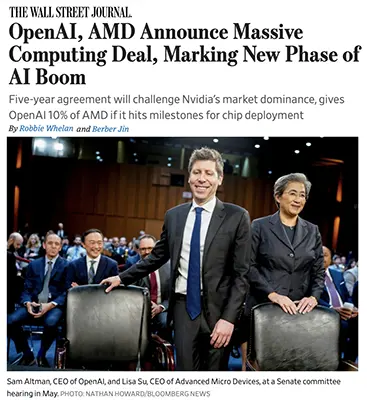
🧠 OpenAI and AMD Announce Massive AI-Chip Deal — WSJ (October 6, 2025)
OpenAI and AMD signed a five-year, multibillion-dollar agreement to power next-generation AI data centers with AMD’s MI450 chips — a direct challenge to Nvidia’s dominance. OpenAI committed to purchasing 6 GW of computefrom AMD, potentially earning up to 10% equity in AMD if performance milestones are hit. The deal could yield tens of billions in revenue for AMD and reshape the AI semiconductor market.
OpenAI CEO Sam Altman said demand for compute is “hard to overstate,” while AMD’s Lisa Su called the partnership “a clear validation of our technology road map.” This comes amid a surge of Altman-led mega-deals — including $300 B with Oracle and $100 B with Nvidia — as OpenAI races to secure capacity for superintelligence development. Analysts warn the frenzy may signal an AI infrastructure bubble, with compute costs soaring to historic levels.
Relevance for Business
SMB leaders should note how strategic hardware partnerships are defining AI’s trajectory. As compute becomes the new “oil,” access to scalable GPU alternatives may lower future barriers for smaller firms adopting AI infrastructure.
Calls to Action
🔹 Monitor emerging non-Nvidia chip ecosystems (AMD, Broadcom, Intel).
🔹 Explore cloud providers offering MI-series GPUs for cost-efficient AI workloads.
🔹 Prepare for price volatility in compute-intensive services through 2026.
Summary by ReadAboutAI.com
https://www.wsj.com/tech/ai/openai-amd-deal-ai-chips-ed92cc42: October 14, 2025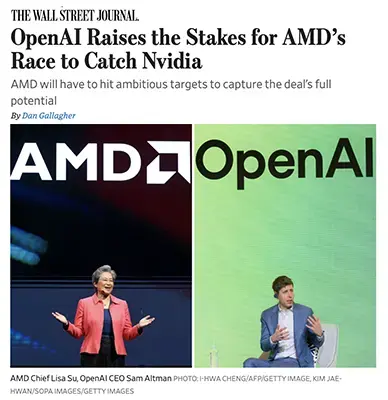
⚙️ OPENAI RAISES THE STAKES FOR AMD’S RACE TO CATCH NVIDIA — WSJ (OCTOBER 6, 2025)
WSJ’s Heard on the Street column analyzed how OpenAI’s 6 GW chip-supply deal with AMD could redefine the GPU market. The deal could add “double-digit billions” to AMD’s annual revenue and gives OpenAI warrants for up to 160 M AMD shares if performance milestones are met. But AMD must deliver at scale to compete with Nvidia’s entrenched lead and its coming Vera Rubin chips.
Analysts see the agreement as a high-risk, high-reward bet: OpenAI gains supply diversity, while AMD faces pressure to prove parity. Investors have already priced in much of the optimism, pushing AMD’s valuation premium above Nvidia’s.
Relevance for Business
This underscores how AI chip supply chains are reshaping capital markets and vendor strategy. For SMBs, chip diversity could reduce dependence on Nvidia-dominated clouds and lower inference costs in coming years.
Calls to Action
🔹 Track AMD MI-series chip adoption among major clouds.
🔹 Diversify AI infrastructure vendors for resilience.
🔹 Anticipate compute-pricing adjustments as competition heats up.
Summary by ReadAboutAI.com
https://www.wsj.com/tech/openai-raises-the-stakes-for-amds-race-to-catch-nvidia-e0bde483: October 14, 2025
⚙️ HOW AMD CAME FROM BEHIND TO MOUNT A CHALLENGE IN THE AI CHIP WARS — WSJ (OCTOBER 6, 2025)
AMD’s transformation from a gaming chip producer to a data-center powerhouse has turned it into Nvidia’s most credible rival in AI semiconductors. Under CEO Lisa Su, AMD’s valuation has soared from $3 billion to $330 billion, driven by its Instinct AI GPUs and a landmark 6 GW compute deal with OpenAI.
The partnership grants OpenAI warrants for up to 160 million AMD shares if milestones are met, positioning AMD for potential $1 trillion market capitalization. Analysts say AMD’s lower prices, efficiency gains, and rising inference demand make it the leading alternative in a market long dominated by Nvidia.
Relevance for Business
AMD’s resurgence underscores the value of strategic pivots and long-term innovation in a high-capital industry. For SMB executives, it demonstrates how focused repositioning can turn legacy strengths into competitive advantages in emerging tech markets.
Calls to Action
🔹 Track GPU pricing trends and vendor diversification across clouds.
🔹 Watch for inference-as-a-service opportunities in 2026.
🔹 Explore AMD’s Instinct line for affordable AI workloads.
Summary by ReadAboutAI.com
https://www.wsj.com/tech/ai/amd-openai-chip-deal-nvidia-competitor-37692514: October 14, 2025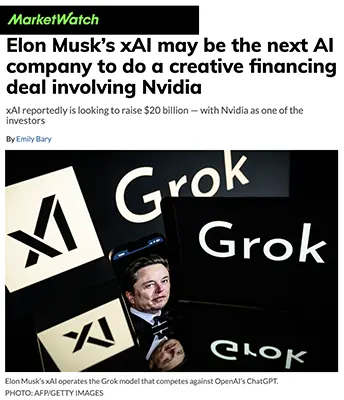
💸 ELON MUSK’S XAI MAY BE THE NEXT AI COMPANY TO DO A CREATIVE FINANCING DEAL INVOLVING NVIDIA — MARKETWATCH (OCTOBER 7, 2025)
xAI, Elon Musk’s AI venture behind the Grok model, is reportedly structuring a $20 billion financing deal combining equity and debt through a special-purpose vehicle that would buy Nvidia GPUs and rent them back to xAI. Nvidia may invest up to $2 billion directly in the venture, blurring the line between supplier and investor.
This “circular financing” trend—where Nvidia invests in AI firms that in turn buy its chips—has raised concerns of market froth. Yet it also signals Nvidia’s strategy to lock in demand and maintain ecosystem dominance, following similar $100B partnerships with OpenAI and CoreWeave.
Relevance for Business
This model highlights how capital structure innovation is becoming critical in AI’s high-cost ecosystem. For SMBs, it underscores the importance of creative financing partnerships and supply-chain agility in tech procurement.
Calls to Action
🔹 Study hardware-leasing models for scaling AI workloads.
🔹 Evaluate vendor financing options tied to GPU supply.
🔹 Track Nvidia’s expanding investment footprint in AI startups.
Summary by ReadAboutAI.com
https://www.marketwatch.com/story/elon-musks-xai-may-be-the-next-ai-company-to-do-a-creative-financing-deal-involving-nvidia-2d2705c0: October 14, 2025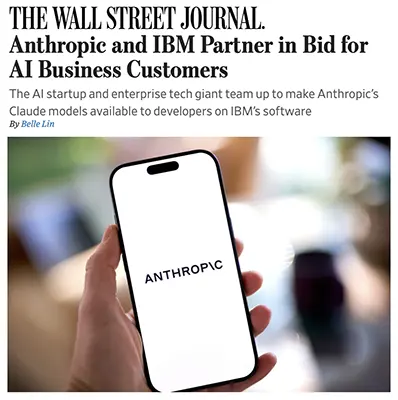
🤝 ANTHROPIC AND IBM PARTNER IN BID FOR AI BUSINESS CUSTOMERS — WSJ (OCTOBER 7, 2025)
Anthropic and IBM announced a strategic partnership to integrate Anthropic’s Claude AI models into IBM’s enterprise software, starting with its new integrated developer environment (IDE). The move expands Claude’s reach into corporate settings, automating coding and modernization tasks. IBM will also publish a guide for building AI agentsusing Anthropic’s Model Context Protocol (MCP) — an open standard that connects AI models to business systems.
Anthropic’s enterprise push continues after recent deals with Deloitte (470,000 employees) and Databricks, while IBM gains access to one of the most advanced LLMs to complement its own Granite models. Both firms aim to leverage their strengths — Anthropic’s technical agility and IBM’s enterprise credibility — to accelerate AI adoption across large organizations.
Relevance for Business
This alliance signals the mainstreaming of safe, enterprise-grade AI. For SMBs, it points toward a future of modular AI integration via open standards like MCP, enabling plug-and-play automation within existing software stacks.
Calls to Action
🔹 Track MCP adoption as a potential integration framework for business automation.
🔹 Evaluate Claude-powered tools emerging within IBM’s ecosystem.
🔹 Benchmark internal AI readiness for agent-based workflows.
Summary by ReadAboutAI.com
https://www.wsj.com/articles/anthropic-and-ibm-partner-in-bid-for-ai-business-customers-f64dee55: October 14, 2025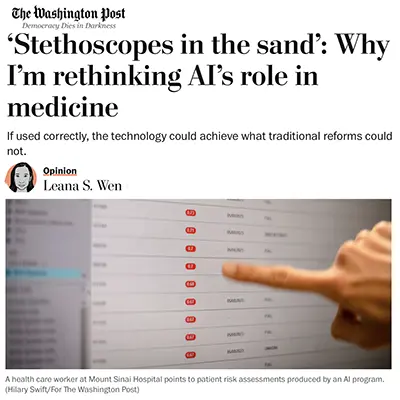
🩺 “AI Is Health Care’s Last Best Hope” — The Washington Post, October 7, 2025
Summary:
Dr. Leana Wen reviews Charlotte Blease’s new book “Dr. Bot: Why Doctors Can Fail Us — and How AI Can Save Lives,” arguing that AI could address systemic healthcare inequities. With over 27 million uninsured Americans and 200,000 preventable deaths annually, AI’s potential lies in scaling access to diagnosis, documentation, and treatment. AI-assisted colonoscopies, mammograms, and patient documentation are already improving efficiency and accuracy.
Blease envisions AI extending healthcare to those without access — for example, AI-powered prenatal ultrasounds in low-resource regions. However, she cautions that AI must complement human care, not replace it, and urges the medical field to train new professionals with AI literacy. The challenge lies in ensuring AI serves patients, not profits, and avoids deepening inequality.
Relevance for Business:
For SMB executives — particularly in healthcare, insurance, and HR sectors — this reflects a broader shift: AI as an equity multiplier. Just as AI could bridge healthcare gaps, it can close operational gaps in small businesses by scaling expertise, automating documentation, and improving decision accuracy.
Calls to Action:
🔹 Identify areas where AI can expand service access (customer care, onboarding, data analysis).
🔹 Develop AI training programs for teams — mirroring the “AI-literate clinician” model.
🔹 Ensure ethical AI use: transparency, fairness, and accountability in automated decisions.
🔹 Partner with AI vendors that emphasize equitable outcomes, not just automation speed.
Summary by ReadAboutAI.com
https://www.washingtonpost.com/opinions/2025/10/07/ai-artificial-intelligence-health-care-dr-bot/: October 14, 2025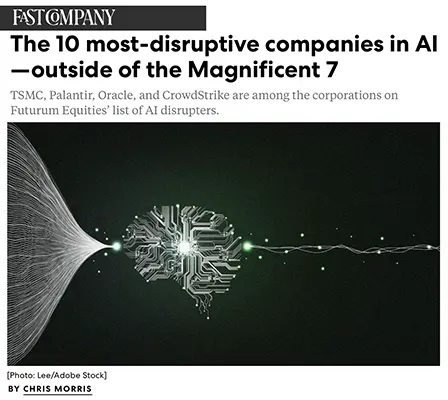
🧩 THE 10 MOST DISRUPTIVE COMPANIES IN AI—OUTSIDE THE MAGNIFICENT 7 — FAST COMPANY (SEPTEMBER 30, 2025)
Fast Company spotlights ten non–Big Tech disruptors shaping the AI economy. According to Futurum Equities, these firms are essential to the “next layer” of AI infrastructure.
Leading the list are:
1️⃣ Broadcom – “the glue” of AI infrastructure via $10B chip deals with OpenAI.
2️⃣ TSMC – “the beating heart” of the global silicon supply chain.
3️⃣ Palantir – building the control layer for real-world AI deployment.
4️⃣ ASML – “the kingmaker” enabling chip manufacturing.
5️⃣ Oracle – a data moat anchoring AI cloud infrastructure.
6️⃣ Astera Labs – solving interconnect bottlenecks.
7️⃣ AMD – scaling AI chip alternatives.
8️⃣ Cloudflare – optimizing global AI data flow.
9️⃣ CrowdStrike – securing AI systems autonomously.
🔟 Palo Alto Networks – integrating scalable AI security frameworks.
Relevance for Business
These firms demonstrate the decentralization of AI value creation beyond Big Tech. SMB executives should monitor how infrastructure innovation trickles down into affordable, modular AI services.
Calls to Action
🔹 Track B2B opportunities with secondary AI infrastructure providers.
🔹 Diversify vendor reliance beyond the Magnificent 7.
🔹 Leverage security and data-flow innovations from these firms.
Summary by ReadAboutAI.com
https://www.fastcompany.com/91412632/futurum-ai-magnificent-seven-economy-nvidia-tsmc-oracle-crowdstrike: October 14, 2025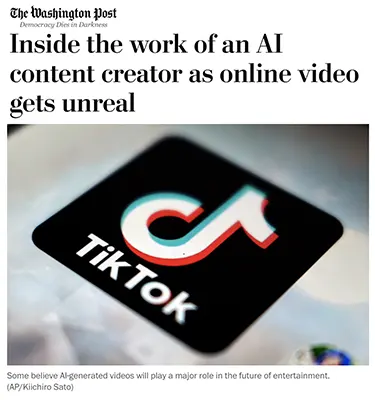
🦍 THE CREATOR BEHIND AI-GENERATED TIKTOK STAR “KIM THE GORILLA” — THE WASHINGTON POST (OCTOBER 5, 2025)
The Washington Post profiles Vito Giovannetti, a 23-year-old Italian creator who built Kim the Gorilla, a photorealistic AI-generated influencer with over 12 million TikTok followers.
Kim’s success shows how AI avatars can achieve fame and sponsorships without real-world logistics. Giovannetti uses Midjourney, Runway, and ElevenLabs to produce daily content, claiming $20,000 monthly ad revenue. Yet critics warn the phenomenon commodifies culture and erases human authenticity — Kim often promotes brands without disclosure that “she” isn’t real.
TikTok has yet to enforce labeling, illustrating how AI-generated personalities are outpacing platform policy.
Relevance for Business
AI-generated influencers mark a shift in digital marketing economics — scalable, tireless, and controversy-free. For SMBs, they present both cost-effective opportunities and ethical pitfalls.
Calls to Action
🔹 Consider AI avatars for low-risk brand campaigns.
🔹 Clearly disclose synthetic creators to preserve trust.
🔹 Watch evolving platform labeling requirements.
Summary by ReadAboutAI.com
https://www.washingtonpost.com/politics/2025/10/09/tech-brief-ai-tiktok-slop/: October 14, 2025
⚠️ LET’S STOP SORA AND META’S VIBES-BASED SLOP BEFORE IT’S TOO LATE — THE VERGE (OCTOBER 4, 2025)
Fast Company reposts The Verge’s editorial, criticizing the flood of AI-generated video “slop” from OpenAI’s Sora and Meta’s Vibes, arguing that social platforms are being overrun with low-effort, synthetic media. The piece warns that users are becoming desensitized to authenticity, while companies profit from engagement algorithms pushing AI content .
It calls for platform-level moderation and regulation of generative content pipelines, urging tech firms to address misinformation and digital pollution before AI replaces genuine creativity.
Relevance for Business
SMBs using AI in content marketing must balance automation efficiency with brand authenticity. Overuse of generative tools risks audience trust and long-term engagement quality.
Calls to Action
🔹 Audit your AI-generated content for quality and transparency.
🔹 Prioritize authentic storytelling alongside automation.
🔹 Support platforms with clear content provenance policies.
Summary by ReadAboutAI.com
https://www.fastcompany.com/91414236/openai-sora-deepfake-sam-altman: October 14, 2025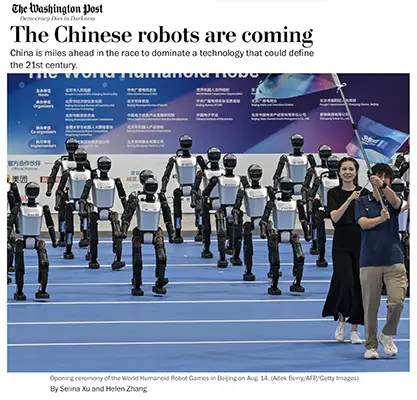
🤖 CHINESE AI ROBOTICS TECH OUTPACES U.S., REST OF WORLD — THE WASHINGTON POST (OCTOBER 10, 2025)
A Washington Post analysis reports that China now leads in humanoid robotics and physical AI patents, outpacing the U.S. in both manufacturing and export volume.
Chinese firms like Fourier Intelligence, UBTech, and Unitree are mass-producing humanoid service robots for logistics, healthcare, and education. Meanwhile, U.S. startups struggle with supply-chain costs and regulatory lag. Experts warn that this “AI-industrial gap” mirrors past chip dependence — a long-term strategic disadvantage if not addressed through R&D investment and industrial policy.
The piece also highlights cross-border tensions, as Chinese robots gain footholds in European and Latin American markets.
Relevance for Business
This shift signals a manufacturing and competitiveness challenge for Western SMBs. Robotics-driven industries may see rising import dependencies unless local AI-mechanical innovation accelerates.
Calls to Action
🔹 Evaluate partnerships with emerging robotics suppliers.
🔹 Support domestic AI-manufacturing initiatives.
🔹 Monitor policy incentives around AI robotics investment.
Summary by ReadAboutAI.com
https://www.washingtonpost.com/opinions/2025/10/09/china-robotics-humanoid-technology-advances/: October 14, 2025
📰 RELATIVELY FEW AMERICANS ARE GETTING NEWS FROM AI CHATBOTS LIKE CHATGPT — PEW RESEARCH CENTER (OCTOBER 2025)
A new Pew Research Center survey found that while 23% of U.S. adults have tried using AI chatbots for news, only 2% rely on them regularly. Most users still prefer traditional outlets or curated newsletters .
Among frequent chatbot users, younger adults (under 35) and tech workers dominate the demographic, but skepticism remains high — 58% of respondents say they don’t trust AI for accuracy or bias. Interestingly, 40% of users cross-check AI-generated summaries against original sources, showing a cautious adoption pattern.
The findings suggest AI chatbots serve as secondary news filters rather than replacements, complementing rather than displacing human journalism.
Relevance for Business
AI chatbots may soon become brand-adjacent information gateways. SMB leaders can leverage these platforms for summarization, internal briefs, and customer education, but credibility remains key.
Calls to Action
🔹 Test chatbot-based content delivery pilots for internal updates.
🔹 Maintain human editorial oversight to ensure accuracy.
🔹 Track consumer trust metrics toward AI-generated content.
Summary by ReadAboutAI.com
https://www.pewresearch.org/short-reads/2025/10/01/relatively-few-americans-are-getting-news-from-ai-chatbots-like-chatgpt/: October 14, 2025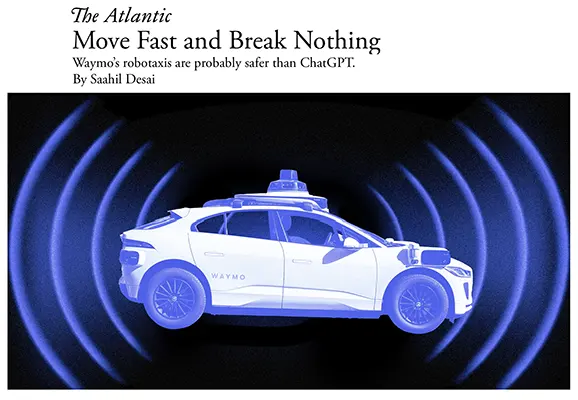
🚗 MOVE FAST AND BREAK NOTHING — THE ATLANTIC (OCTOBER 2, 2025)
Saahil Desai contrasts Waymo’s safety culture with the reckless pace of AI model releases.
Waymo, Alphabet’s self-driving subsidiary, has logged 96 million autonomous miles with 91% fewer serious accidents than human drivers. Despite rare glitches (cement traps, illegal U-turns), its approach of slow, data-rich expansion across five U.S. cities stands in stark contrast to the “move fast and break things” ethos driving OpenAI, Tesla, and others. Tesla’s robotaxis logged three crashes in their first month, while Cruise’s service collapsed after a high-profile pedestrian injury.
Desai argues Waymo’s measured engineering discipline offers a counter-narrative to AI hype. While OpenAI rushes toward superintelligence, Waymo methodically builds infrastructure meant to last — potentially becoming a future public utility.
Relevance for Business
The article reinforces the value of deliberate innovation. For SMBs exploring AI integration, it highlights that trust, testing, and safety are competitive assets, not bottlenecks.
Calls to Action
🔹 Adopt “safety-by-design” frameworks for AI and automation rollouts.
🔹 Benchmark internal AI ethics policies against Waymo-style verification models.
🔹 Communicate risk mitigation as part of your brand trust strategy.
Summary by ReadAboutAI.com
https://www.theatlantic.com/technology/2025/10/is-waymo-safe/684432/: October 14, 2025
⚙️ PHYSICAL AI EXPLAINED: EVERYTHING YOU NEED TO KNOW — TECHTARGET (AUGUST 2, 2024)
TechTarget’s Andy Patrizio defines “physical AI” as the merger of artificial intelligence and robotics, enabling machines to sense, reason, and act autonomously within the physical world.
Unlike generative AI, which depends on text or images, physical AI relies on sensors, actuators, and real-time environmental data. Applications include autonomous vehicles, medical robotics, environmental monitoring, and hazardous task automation. The article emphasizes that physical AI systems are adaptive and embodied, learning through direct experience rather than static datasets.
The next frontier: human-robot collaboration, where physical AI augments precision work in manufacturing and healthcare.
Relevance for Business
Physical AI expands automation into real-world operations, offering SMBs efficiency, precision, and safety improvements — especially in logistics, construction, and healthcare.
Calls to Action
🔹 Audit manual processes suitable for robotic augmentation.
🔹 Train staff for human-robot interaction.
🔹 Explore sensor-driven AI systems for operational analytics.
Summary by ReadAboutAI.com
https://www.techtarget.com/whatis/feature/Physical-AI-explained-Everything-you-need-to-know: October 14, 2025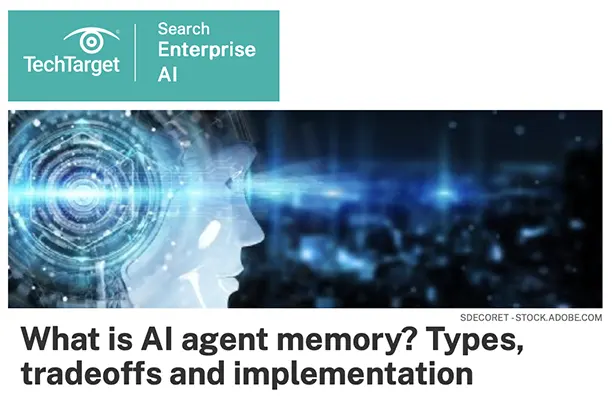
🧠 “What Is AI Agent Memory? Types, Tradeoffs and Implementation” — TechTarget, October 3, 2025
Summary:
AI agent memory allows AI systems to store, recall, and learn from past interactions, enabling smarter, more autonomous operations beyond simple rule-based automation. The article defines short-term memory (STM) as temporary context (like a chat window) and long-term memory (LTM) as a persistent store of data for personalization, reasoning, and adaptation. LTM is further divided into episodic, semantic, and procedural types — mirroring human memory functions.
Key tradeoffs include depth vs. efficiency, reliability vs. autonomy, and cost vs. performance. Frameworks like LangChain, LlamaIndex, and Semantic Kernel implement these memory architectures, often combining databases, retrieval-augmented generation (RAG), and vector embeddings. Businesses can use AI memory to enhance decision-making, workflow optimization, personalization, and knowledge management.
Relevance for Business:
AI memory is the backbone of agentic AI, which will underpin future business automation systems. For SMBs, it means moving from “AI chatbots” to autonomous assistants that can recall previous projects, clients, and outcomes. Memory-enabled systems can improve customer retention, reduce redundant tasks, and enable data-driven decisions across sales, HR, and operations.
Calls to Action:
🔹 Evaluate current AI workflows — can they retain context across sessions?
🔹 Pilot a memory-enabled agent (e.g., using LangChain or LlamaIndex) for internal knowledge retrieval.
🔹 Design data governance policies for AI memory — including what data is stored, how long, and who can access it.
🔹 Start small: test short-term vs. long-term memory tradeoffs before scaling enterprise-wide.
Summary by ReadAboutAI.com
https://www.techtarget.com/searchenterpriseai/tip/What-is-AI-agent-memory-Types-tradeoffs-and-implementation: October 14, 2025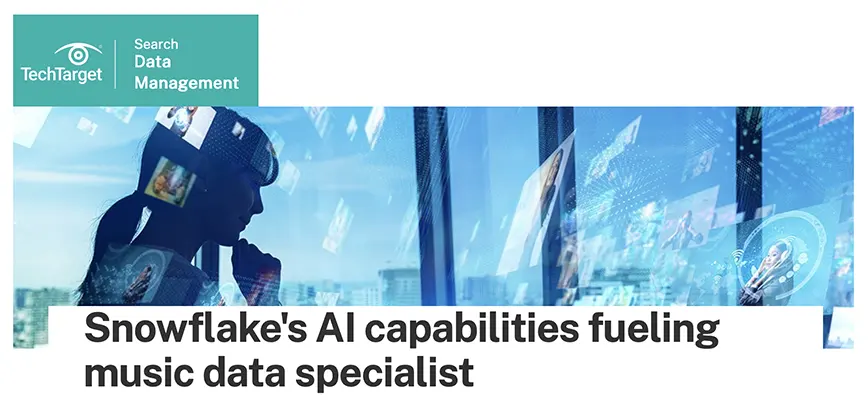
🎶 SNOWFLAKE’S AI CAPABILITIES FUELING MUSIC DATA SPECIALIST LUMINATE — TECHTARGET (SEPTEMBER 29, 2025)
Luminate, the data company behind Billboard’s charts, has rebuilt its infrastructure on Snowflake and AWS, launching an AI-powered agent called Lumi that autonomously surfaces insights for clients in the music and entertainment industries. Lumi uses Anthropic’s Claude LLM via Snowflake Cortex AI, enabling automated anomaly detection and content summaries.
The collaboration reflects Snowflake’s evolution into an AI-development platform under CEO Sridhar Ramaswamy, focusing on enabling enterprises to deploy agentic AI applications securely on proprietary data.
Relevance for Business
This case exemplifies how AI-native data infrastructure can transform decision-making in creative and analytics-heavy industries. SMBs can apply similar architectures for scalable AI adoption without abandoning legacy systems.
Calls to Action
🔹 Explore Cortex or similar platforms for data-to-AI integration.
🔹 Study agentic AI for industry-specific insight generation.
🔹 Invest in data unification to prepare for AI applications.
Summary by ReadAboutAI.com
https://www.techtarget.com/searchdatamanagement/feature/Snowflakes-AI-capabilities-fueling-music-data-specialist: October 14, 2025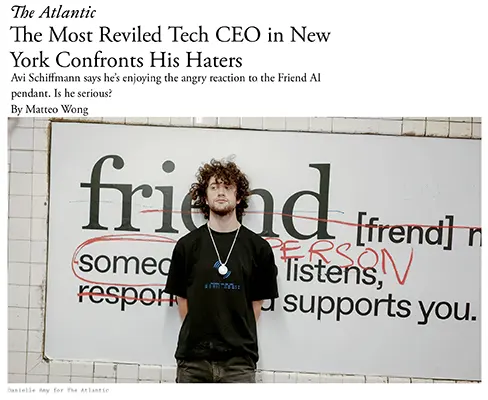
🧠 A WALK WITH NEW YORK’S MOST HATED TECH FOUNDER — THE ATLANTIC (OCTOBER 6, 2025)
Matteo Wong profiles Avi Schiffmann, creator of the viral “Friend” AI pendant and target of cultural backlash.
The $129 wearable AI pendant “Friend” sparked outrage across New York after 10,000 subway ads promoted it as a “wearable companion.” Vandals covered the posters with anti-AI graffiti, turning them into public art. Schiffmann claims the controversy was intentional, describing his campaign as “performance marketing meets postmodernism.”
Despite limited sales (~1,000 devices), Schiffmann’s strategy of courting hate to spark “mindshare” reflects how younger founders use provocation to engage public debate about AI companionship and loneliness. Critics see Friend as dystopian; Schiffmann calls it “a therapist, a best friend, and a god.”
Relevance for Business
This case illustrates how provocative branding can drive visibility in the AI era — but also risks public distrust. SMB leaders should balance attention-grabbing campaigns with authenticity and sensitivity to consumer ethics.
Calls to Action
🔹 Evaluate the ethics of emotional-AI products and marketing.
🔹 Anticipate backlash when merging AI with intimacy or identity.
🔹 Treat controversy as data — but not as strategy.
Summary by ReadAboutAI.com
https://www.theatlantic.com/technology/2025/10/friend-ai-companion-ads/684451: October 14, 2025
💸 SPENDING ON AI IS AT EPIC LEVELS. WILL IT EVER PAY OFF? — WALL STREET JOURNAL (SEPTEMBER 25, 2025)
The Wall Street Journal reveals that AI infrastructure spending has surpassed the inflation-adjusted cost of the U.S. interstate highway system. Major firms like Microsoft, Meta, and OpenAI are spending hundreds of billions on massive data centers—many still years from profitability.
The article likens the moment to the dotcom overbuild of the late 1990s, when optimism outpaced returns. Bain & Co. estimates AI infrastructure will need $2 trillion in annual revenue by 2030 to justify current investments. Meanwhile, firms like CoreWeave, backed by Nvidia and private equity, are leveraging heavy debt to finance data-center expansion.
Despite parallels to past bubbles, executives like Satya Nadella and Larry Ellison argue that AI’s adoption curve will deliver returns faster than the internet era, citing productivity gains and job automation as long-term payback.
Relevance for Business
This underscores the capital intensity and risk of the AI arms race. SMBs should stay adaptive, focusing on measurable ROI and scalable investments, not speculative spending.
Calls to Action
🔹 Adopt modular AI tools with short payback windows.
🔹 Track cloud provider debt exposure and pricing impacts.
🔹 Prepare contingency plans for market corrections in AI infrastructure.
Summary by ReadAboutAI.com
https://www.wsj.com/tech/ai/ai-bubble-building-spree-55ee6128?mod=tech_trendingnow_article_pos5: October 14, 2025
💼 BLACKROCK GROUP HUNTS A $20 B DEAL TO GET IN ON THE AI BOOM — WSJ (OCTOBER 3, 2025)
Investment giant BlackRock, along with partners Microsoft and Mubadala’s MGX, is nearing a $20 B acquisition of Aligned Data Centers—its first move under the Global AI Infrastructure Investment Partnership, a consortium targeting $100 B in AI-related assets. The deal would make BlackRock a heavyweight in the data-center build-outpowering generative AI.
Rivals including KKR, Apollo, and Blackstone are pouring billions into similar projects. Analysts warn of over-investment risks, but energy and power demands from AI systems continue to attract record capital inflows.
Relevance for Business
This is a clear signal that AI infrastructure has become an institutional asset class. For SMB executives, expect a ripple effect in cloud costs, real-estate pricing, and energy infrastructure as capital floods into AI data centers.
Calls to Action
🔹 Track AI-infrastructure investments that could shift cloud pricing.
🔹 Consider partnerships with local data-center developers.
🔹 Prepare for energy-capacity pressures impacting operations.
Summary by ReadAboutAI.com
https://www.wsj.com/tech/ai/blackrock-group-hunts-a-20-billion-deal-to-get-in-on-the-ai-boom-91c56dd2: October 14, 2025
Closing Summary: AI update for October 14, 2025
AI’s story this week is one of convergence—tools, ethics, and infrastructure tightening into a more regulated, business-ready ecosystem. From policy to robotics, the choices leaders make now will define how responsibly and profitably their organizations ride the next wave of AI adoption.
All Summaries by ReadAboutAI.com
↑ Back to Top
